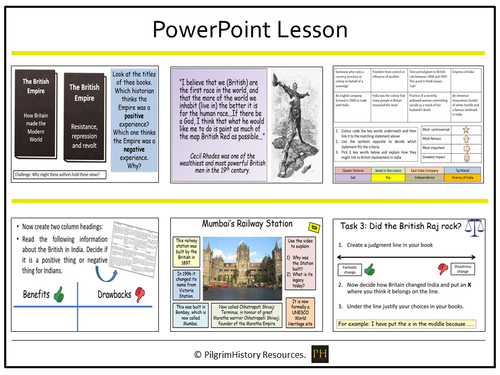


The British Empire
The aims of the lesson are to decide who were the main beneficiaries of British rule in India.
The opening slides introduce the views of modern historians to those at the time such as Cecil Rhodes, with a video link setting the scene for British rule in India and a thinking quilt to challenge students.
Throughout, students are encouraged to gather and analyse the evidence to make their own judgements and conclusions.
There are some beneficial aspects to British rule shown such as the building of railways, the provision of education and the introduction of law and order in the country. A focus on Mumbai’s railway station facade and its network cites the legacy of Empire as well.
But at the same time a lack of sympathy for traditional customs and religious beliefs, an inadequacy of Indian officials in Government and the promotion of British wealth and power above all else will give students a lot of conflictory evidence.
In the plenary, students will rate how beneficial an Empress Queen Victoria actually was for bringing India under direct British control.
The lesson comes with retrieval practice activities, suggested teaching and learning strategies, differentiated materials and is linked to the latest historical interpretations, video clips and debate.
The lesson is enquiry based with a key question posed at the start of the lesson and revisited at the end to show the progress of learning.
The lessons are fully adaptable in PowerPoint format and can be changed to suit.
Something went wrong, please try again later.
This resource hasn't been reviewed yet
To ensure quality for our reviews, only customers who have purchased this resource can review it
Report this resourceto let us know if it violates our terms and conditions.
Our customer service team will review your report and will be in touch.